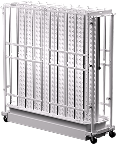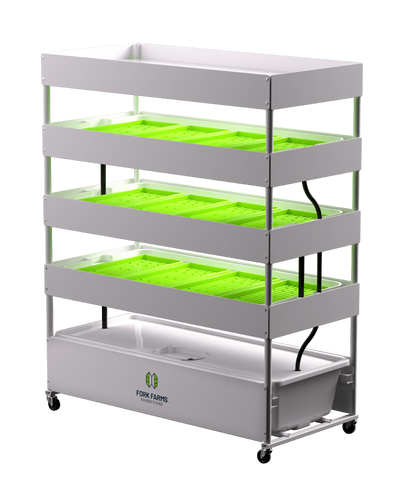How to Start a Hydroponic School Lunch Program: What are the Steps?
Thinking about putting hydroponics into your school lunch program, but don’t know where to start? School lunch programs are more important now than ever since post-pandemic, we have realized how crucial school meals are for the health and well-being of all students. We like to say that starting a hydroponic school lunch program is like planting seeds of the future. It's hands-on learning with a delicious payoff.
The fact that you are thinking about a hydroponic school lunch program, means you are taking the first step in this process. Curiosity is key. Oftentimes school foodservice directors hear about introducing hydroponics into their school lunch programs, and they are then either petrified or intrigued by the concept.
Growing hydroponics indoors is actually quite simple once you have the routine down. You don’t need to be an expert farmer or have a degree in agriculture to set up a hydroponic farm and then maintain it. The most important thing you need is an interest in simply growing foods and plants hydroponically. We know at Fork Farms, that even elementary-age students help grow foods in our Flex Farms, so anyone can engage in the process.
The one thing we hear the most from schools is their eagerness to improve the quality and availability of fresh food in their school(s). Coupled with that, school food service directors often want to take on a larger role within the school and combine nutrition and education.
Here are some steps you can take to see if adopting hydroponics into your school lunch program is right for you and your team.
Ask yourself a couple of questions right off the bat:
- “What is it about hydroponics in schools that is interesting enough to you that you’d like to learn more and possibly take on a new project?”
- “Why are you curious?”
- “How do you envision hydroponic growing in your school - in the classroom, in the cafeteria or both?”
- “How invested can you be in the project and can you also drum up support from others in your organization to make this a success?”
If you have passion, curiosity, vision and are ready to give it a go, follow these steps to begin to initiate a program. Again, hydroponics in general and in school lunch programs is not complicated, these steps just provide detail for those who love specifics.
Research and Plan Your Hydroponic School Garden
- Learn about hydroponic growing techniques and their feasibility for your school
- Keep in mind that if you choose the right equipment, running a hydroponic program is quite simple
- Research existing hydroponic school programs to gather insights and best practices
- Options are endless. Some schools have small tabletop hydroponic growing systems, while others have a whole family of farms
- Learn more from some of our partners, Ashwaubenon School District and Redding Elementary School District re: how they have used hydroponic farms to support both classroom learning and in their school lunch program.
Assess Availability of Space With Your School Garden Location
- Evaluate available space within the school premises for setting up hydroponic systems. This could include classrooms, cafeterias or unused areas. We’ve seen spaces such as old locker rooms or storage rooms turned into blooming hydroponic growing rooms
- Collaborate with school facilities managers to get them on board to help you find space to grow.
Evaluate Resources and Build a Support Team
- Assess the availability of volunteers or staff members who can help you oversee the program from teachers to students to community members
- Organization is key - have a plan in place for the minute the hydroponic farm arrives on-site to its first harvest:
- Designate a group to assemble the farm when it arrives. This should take less than an hour to complete
- Craft a schedule for who will maintain the farm for the first few months. Customers tell us 1-3 hours per month does the trick
- Collaborate with teachers to let them know about the many ways the farm can be used as a teaching tool.
Get creative re: how to pay for the hydroponic farm at your school -
- Although it may seem backward, we have seen it work in many cases where the school’s food service director builds the vision and then finds the support they need to fund the vision
- Research available grant opportunities and explore options for financial support. There are numerous government grants available to support indoor hydroponic growing all across the country to make this type of farming more attainable to more people. Let us know if you’d like to learn more from our team on this topic
- Collaborate with Special Education, STEM, AP Biology programs, Culinary programs and more to find your advocates in moving forward with the project. If you build the vision, they will come.
Select Your Hydroponic System -
- When you have an idea of available space, budget, support staff and educational goals, it’s time to choose the appropriate type of hydroponic system for your school
- The system you choose should have high-quality seeds or seedlings, nutrient solutions and more to make sure you are set up for success.
Curriculum Integration With Your Hydroponic Garden -
Hydroponics offers hundreds of learning opportunities for students in the areas of: STEM, nutrition, agriculture, sustainability and health. By combining hands-on experimentation in real-world farming scenarios, interdisciplinary learning, and technology, hydroponics provides numerous benefits for students' engagement, critical thinking and problem-solving skills. More on this can be found in a recent issue of STEM Magazine.
- Start to gather educational materials and activities to engage students in hands-on learning experiences related to hydroponics. At Fork Farms, all in the education space who use our Flex Farms receive a complete K-12 curriculum for recommended learning in the classroom
- As the project lead, dive into the curriculum and share your learnings with other teachers in the school to build excitement around the various learning opportunities around the hydroponic farm.
Pitch your Plan to School Administrators -
Gather your best talking points, pitch your hydroponic farm to school administrators and highlight your vision of nutrition, health, education and sustainability in one compact unit. Once approvals are in place, it's time to Get ready to Know it, Grow it and ultimately Show it.
Setup and Installation of the Hydroponic Garden -
- Set up the hydroponic systems according to manufacturer instructions or guidelines provided by experts. We can’t speak to other indoor hydroponic farms, but our customers would attest that it typically takes them less than an hour to complete the initial setup and installation of their Flex Farm
- Put together a schedule for who will maintain the hydroponic farm and conduct regular tasks such as: checking nutrient levels, adjusting pH, pruning plants, and cleaning equipment
- If you set up the program correctly from the start, maintaining the farm is not time-consuming, and serves as beneficial learning opportunities for students. On average, our customers spend about 1 – 3 hours per month maintaining their Flex Farm. This includes the time it takes to plant seeds, transplant seedlings, and harvest the crop
- The farm is quite self-sufficient, but if students give it more attention, the farm will likely yield more fresh food. Students who maintain the farm ultimately define the success of the farm.
Enjoy the fruits of your labor: Harvesting and Food Preparation -
- Teach students proper harvesting techniques and food safety practices
- Incorporate harvested produce into school meals or snacks, either through on-site cooking or collaborations with cafeteria staff
- Celebrate the harvest and host a harvest party. Teach students how to make fresh pesto from the basil they have grown hydroponically, host a lettuce tasting in the school cafeteria and celebrate a job well done.
Community Engagement -
- Promote the hydroponic program within the school community and beyond through events, workshops, and social media
- Involve and engage parents, local businesses, and community members as volunteers or supporters of the program
- Depending on your yield, if there is excess fresh food, the school can donate to a local food bank or shelter.
Evaluation and Expansion -
- Continuously evaluate the success of the hydroponic program based on educational outcomes, student engagement, and production yields
- Gather feedback from students, teachers, and other stakeholders to identify areas for improvement
- Consider expanding the program by adding more hydroponic systems, introducing new crops, or partnering with other schools or organizations. Products like the Fork Farms Flex Connect link multiple Flex Farms together making growing more fresh food as simple and efficient as possible.
To bring things full circle, again, starting a hydroponic school lunch program is like planting seeds of the future. Year-round and on-site nutrition and learning can come in one hydroponic package. We urge you to see if adding hydroponics into your school lunch program is the green ticket.
Special thanks to Sue Malesa, Associate Vice President, Culinary and Food Service with Fork Farms, who has been in the school foodservice industry and involved in the School Nutrition Association for more than 25 years for her expert advice on this topic.
Important Links:
























